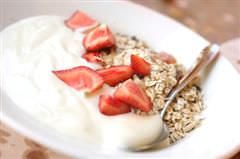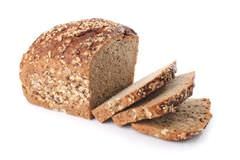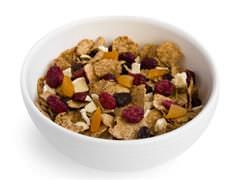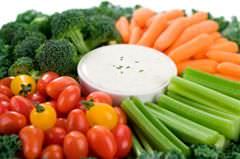By SparkPeople Head Dietitian Becky Hand, RD, LD
Despite all the bad news out there about our collective health declining, it's easier than ever to eat right and improve your health. As 2010 draws to a close and we prepare for a healthy and happy 2011, we took a look back at the healthy eating trends that have transformed our supermarkets, our eating habits--and our lives--since the start of the 21st century. Read on to find out which 11 (in no particular order) top our list.

- Probiotics:
Years ago, you would have cringed at the idea of billions of bacteria living in your intestines, but today you are probably among the millions who are looking for ways to increase these healthy guys, called probiotics. While we know that there are more than 400 different types of beneficial bacteria in the intestines, we are just beginning to uncover the various roles they play. We should definitely include foods that contain these probiotics, such as yogurt, drinkable and squeezable yogurts, fluid milk with added probiotics, fermented milk such as sweet acidophilus milk, and kefir. (You can also find probiotics in fermented vegetables such as kimchi and sauerkraut.) There is little regulation with probiotic supplements, so always talk to your doctor before using such a supplement.

- Farmers Markets:
Farmers markets are popping up in communities large and small with fresh, local produce that is affordably priced available to all. Whether you are looking for a creative way to expose your family to fresh fruits and veggies, wanting to support your local farmer, searching for more organic options, or showing support for environmentally friendly and sustainable farming practices, the local farmers market has something for everyone.

- Omega-3 Fatty Acids:
After the fat-free craze of the 90s, a superstar fat took center stage. Found in flaxseed, fatty fish, soybeans, and walnuts, omega-3 fatty acids do a body good. These essential polyunsaturated fats have been shown to be beneficial in heart health, bone health, mental health, intestinal health and more!

- Better-for-You Yogurt:
A few years back, yogurt hit its low point: sugary granola, cookie bits, and even chocolate candies were mixed in, and some varieties had more than two tablespoons of sugar (in addition to the natural milk sugars). Lower-sugar and plain yogurt have made resurgence on supermarket shelves, as has Greek-style yogurt, which due to the straining process is higher in protein, and usually lower in carbohydrates and calcium. Thick and tangy, it's livening up dips, replacing mayo and sour cream, and becoming a tart swap for whipped cream on health menus everywhere. Without all the sugar and additives, yogurts real health benefits can shine.

- The Rise of Mixed Greens (and Decline of Iceberg):
Goodbye pale iceberg, hello leafy dark greens. Yes, the likes of spinach, romaine, collard, and kale have added color, texture and taste along with an ample additional of fiber, vitamins and mineral to our salads and cooked vegetable side dishes. From fast food joints all the way up to the finest steakhouses, you can find salads with some heft to them. Your palate and your body will thank you for choosing a more nutritious salad blend.

- Healthier Restaurant Food:
You asked for it, you got it and you were in shock! That’s right, you wanted to be an informed consumer and know the nutritional breakdown of your favorite restaurant and fast food selections. Then when you saw it in print you gasped in horror at the damage you were doing to your body. Giant hamburgers and biggie fries climbed to more than 2,000 calories and an entire day's allowance of fat. Thank heavens that restaurants and fast food joints have started to help out by offering complete meal selections for fewer than 500 calories, along with baked chips, apple slices, carrot sticks, and yogurt as side options.

- Whole Grains for Everyone: Finally, the truth is out… carbohydrates aren’t evil, you just have to know how to select the healthier, whole-grain types in the correct portion sizes and amounts. Awareness and consumer demand has greatly increased your options, and it's easier than ever to find tasty and healthy whole-grain foods. With selections such as whole grain breads, crackers, and cereals, brown rice, and whole wheat pasta, it’s easy to stock up your pantry shelves. It is reassuring to know that you can now provide your body with the energy needed and feed your brain as well by easily selecting your whole-grain products.

- Healthier Breakfast Cereals:
Remember those mornings when you gulped down bowl after bowl of brightly colored, sweetened shapes of highly refined grains that turned your milk pink or blue? You were fascinated by the cartoon character on the box, or the prize inside, and you didn’t realize that you were easily consuming a quarter cup of sugar along the way. This was the typical childhood breakfast for most of us, but the healthy alternatives were boring! Flash forward to today, when the grocery shelves are lined with healthier options that are now made with the whole grain and contain less sugar and more fiber and protein. No longer tasting like cardboard, these cereals can make everyone in the family happy. Top with some fruit and low-fat milk, and you do finally have a breakfast for a champion.

- Ready-to-Eat Vegetables and Fruits:
Steam packs, prechopped/washed slices and stick, a wider variety in the freezer case, and individual portion packs--they're a healthy eater's dream comes true. They're washed, prepped and ready to consume--a busy parent's secret weapon. Canned portion packs of fruits are perfect for anyone’s lunch. A freezer full of vegetable blends can turn any veggie hater into a veggie-connoisseur. You might be paying a bit more, but if you'll actually eat more vegetables, then it's worth it.

- Fiber, Fantastic Fiber:
It’s been a well-known fact that different types of fiber have numerous health benefits in the body. Fiber is involved in the lowering of cholesterol levels, controlling blood sugar levels, preventing certain types of cancer, and of course maintaining a healthy gastrointestinal tract. However, when fiber was shown to be involved in helping with hunger management during weight loss, it took on a life of its own. While searching for high-fiber foods like fruits, vegetables, beans and whole grains, you will likely come across foods that are highly fortified with fiber. However, there is such a thing as too much of a good thing, as this "stealth fiber" is teaching us.

- Eating Meat, but Less of It:
In the words of journalist Michael Pollan: “Eat food. Not too much. Mostly plants.” While meat is an excellent source of protein that is used by the body to maintain muscle mass and provide satiety during weight loss, it still needs to be viewed as a side dish, not the main entrée. That means including a 3-4 ounce cooked portion of lean meat, beef, pork, or fish that covers just 1/4 of your 9-inch plate. Be adventuresome as well, and expand your recipe repertoire to include several meatless meals each week using soy products, beans, legumes, and nuts. Join the movement for Meatless Monday.
Which of these trends have most significantly impacted the way you eat?
|
|











.jpg)

.png)











